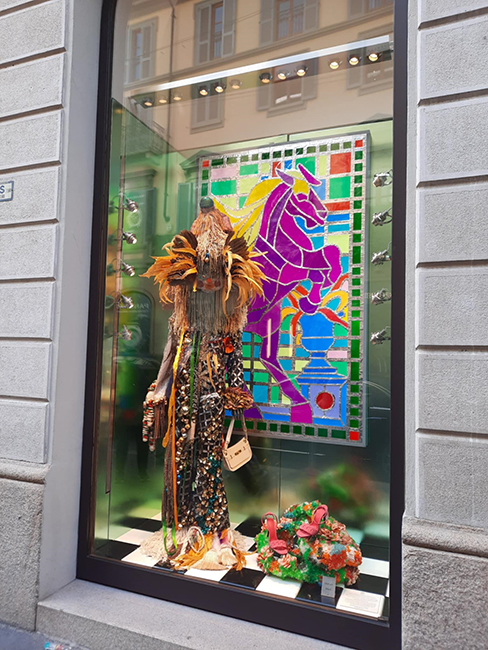
Performance by New York artist Iván Sikic for Aesop– the Australian brand of high-quality products for skin, hair and body
Nowadays, as retail industry is getting more competitive, attracting and retaining customers is an art which top brands have mastered adopting successful visual merchandising. Visual merchandising is more than just arranging products on shelves; it creates a charming shopping experience that catches customers’ attention and persuades them to consume.
It is both an art and a science—a method of showcasing products in visually attractive ways that can drive sales and elevate the shopping experience. We will examine below how visual merchandising boosts sales.
Store windows are a brand’s first point of contact with potential buyers. An attractive, stylish window display can draw the attention and invite customers to enter the store. It arouses curiosity, sparks an interest, and sets the tone for what’s in store. Enchanting window displays have the power to raise traffic and increase sales. Luxury brands are known for their elaborate, story-telling displays that show their identity and philosophy, setting a sophisticated tone for a holistic shopping experience inside. Top brands approach windows layout as art exhibitions, designed to draw passersby’ attention. While this selection can be costly, fundamental principles of visual merchandising can be applied to businesses of all sizes.

"Today" Installation by Raùl de Nieves' for the window display of Hermès' flagship store in Milan (2023)
@decobook
One effective technique is the “Rule of Three,” widely used by visual merchandising experts for both window displays and in-store units. The number three is visually appealing and most proper to solidify the image of a product in the customer’s mind. Thus, products are displayed in sets of three, whether organized by height, size, or price, from smallest to largest. This asymmetry draws attention and intrigues customers to “unexpected” focal points, which stand out compared to more conventional symmetrical arrangements. Additionally the odd number three leaves a lasting impression because odd-numbered groupings are more appealing and memorable.

Another effective approach is the “Pyramid Principle,” where products are arranged in a triangular display, that is, the largest item is placed in the middle, while smaller items are positioned around it, creating a pyramid effect. This principle creates a dynamic display, avoiding a “flat” or “boring” look.




Additionally, colors play a significant role in visual merchandising, as they influence customers’ mood and behavior. A balanced color palette can attract customers and invite them to linger, while a dull color scheme may discourage them. Each color evokes a different emotion—red and yellow exude urgency, blue and green convey calm, white suggests purity, and black evokes sophistication. Brand’s colors have a story to tell to the customers about it. For example black and white palettes convey an air of elegance and power while supporting a brand's mission to provide a high-end, sophisticated image. Furthermore, lighting plays a vital role in reinforcing product’s attractiveness.

Installation for the clothing brand Benetton at the Printemps department store in Paris
Modern lighting placement can enhance the store ambiance and atmosphere and emphasize the finest features of products. Strategic illumination can create focal points that draw attention to key products in order to increase sales.

The Apple Cube store on Fifth Avenue in New York City

Clear and effective communication is very significant in retail sales. Signage should be clear, comprehensive, well-placed in order to help customers navigate a store. This is very crucial for customers in a hurry; it can also encourage additional purchases. Product characteristics, pricing, discounts, and other essential information should be displayed using a readable font, in order to help customers quickly absorb the information.
Refreshing retail displays by changing arrangement, placement, or theme regularly is one more key to keep customers engaged with the brand and avoid “display fatigue.”

In conclusion, visual merchandising is the silent but persuasive seller in retail, influencing dynamically consumers’ behavior. Optimizing retail store design can fascinate and guide customers. Store should become multi-sensory experiences, accomplishing the customers’ preferences. Visual merchandising can transform retail spaces into vibrant shopping destinations, worthwhile for both the business and the customer.
| < Prev | Next > |
|---|


